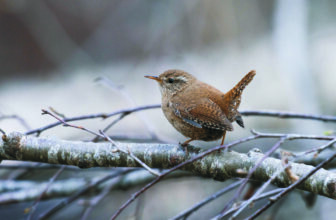
Cormorant
Ramblers, dog walkers and mountain bikers around Cranleigh have been surprised when I’ve shown them the sea from the Surrey Hills, north of the village.
It’s not just the big ships that you can easily spot through binoculars. Even quite small dinghies show up when their white sails catch the sunlight and flash like little searchlights in the distance.
‘Seawatching’ for birds passing the Shoreham Gap around 30 miles away has however, unsurprisingly, proved fruitless for me. But at least there have been a good variety of seabirds turning up in Cranleigh over the years – and some are now annual visitors. So with the holiday season well and truly here, let me welcome you to… Cranleigh-on-Sea.
Nearly every day outside of the breeding season you can look up from the High Street and see large, long necked black looking birds flying overhead, sometimes singly but often in a line.
They look a bit like geese but these are Cormorants. The first of these traditionally coastal birds was recorded here in 1954. But now you can regularly find them along The Cranleigh Waters and small ponds and lakes. As the sport of fishing has prospered so too have the hungry Cormorants.
One bird I’m not so keen on is the Herring Gull, especially since one flew up behind me in St Ives two summers ago, whacked me over the head, and nicked a £2 ice cream from my hand. Gobbled the lot in one go! Fortunately we don’t have to hang on to our ice creams or picnic food here just yet – but we may have to in future if this species continues its spread inland.
Herring Gulls used to be winter visitors but they are spreading to more land-locked counties and in the last few years I have regularly seen them in the summer.
Other gulls, too, are no longer to be found just on beaches. Surrey’s newly-built reservoirs, and the growth of rubbish dumps, encouraged them.
The Black-headed Gull is an abundant winter visitor here – usually to be seen outside the breeding season when they are without their summer ‘hoods’. They love the short turf of Cranleigh cricket pitch and patter their feet hard on the grass to try and attract unsuspecting worms to the surface.
Look among the flocks and you might find a Common Gull. Birds often have misleading names, and this is one. It is not the most common gull around here. You can see them on most winter days but you might have to look through 50 Black-headed Gulls to find just one.
Lesser Black-backed Gulls are not as tame locally as the other two species but they can often be seen on passage or in ploughed fields in the autumn and winter. A few bully Great Black-backed Gulls may be lurking with them.
Gulls are always worth a closer look. Twenty years ago I saw just four gulls on a field near Alderbrook and was delighted to find our first – and so far, only – Yellow-legged Gull. It was regarded as a subspecies then but has since been given full species status.
Last April brought my biggest local gull surprise as an eagle-eyed birding friend –@BirdingGardener – pointed out a summer plumaged Little Gull, lazily circling north some 200 feet above the Surrey Hills with five Lesser Black-backed Gulls.
Another seaside treat regularly seen screeching in early summer around Cranleigh over the last couple of decades is that dainty flyer – the Common Tern, otherwise called the Sea Swallow. They are incredible ocean wanderers and some have been seen over 600 kilometres offshore from Ghana.
More recently they have been encouraged to breed further north in Surrey on specially designed rafts on large stretches of water – well away from the foxes’ reach.
It was amazing to see a pair this year flying over the fields beside the Down’s Link at Rowly. Who knows how many miles they had done and where they had come from. Populations winter as far south as Australia, South Africa and South America.
Fortunately times have changed and birds are generally identified now in the UK by direct observation, photographs or video. A century or more ago, any strange bird tended to be ‘collected’ for identification purposes – which means it was shot.
Such a fate appears to be that of Surrey’s first Roseate Tern, blown out of the sky in Cranleigh in 1873. Another seabird, the Grey Phalarope, met the same sad end in 1900.
Other fabulous seabirds have made it to Cranleigh after being blown down, not by gunfire, but by autumn storms. I will tell you about some of the more outrageous landings next month.
Twitter – @Crane_Spotter











